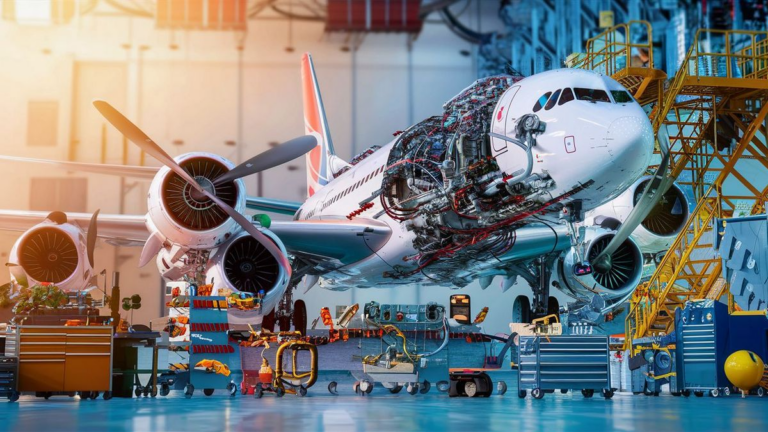An aircraft factory is a crucial hub in the aviation industry, responsible for the production of various components essential for building aircraft, including airplane engines. These engines serve as the heart of any aircraft, powering them through the skies with efficiency and reliability. Let’s delve into the intricate process of how an aircraft factory manufactures airplane engines.
Design and Engineering
Before the manufacturing process begins, a team of skilled engineers meticulously designs the airplane engines. This stage involves extensive research, computational fluid dynamics (CFD) simulations, and testing to ensure optimal performance, fuel efficiency, and safety. Every aspect, from the engine’s architecture to its materials, is carefully considered to meet the stringent standards set by aviation regulatory bodies.
Materials Selection
The next step involves selecting the materials that will compose the engine components. Aerospace-grade alloys, such as titanium, aluminum, and nickel-based superalloys, are often preferred due to their high strength-to-weight ratios, heat resistance, and durability. These materials undergo rigorous testing to ensure they meet the exacting standards required for aviation applications.
Manufacturing Processes
Once the design and materials are finalized, the manufacturing process commences. Aircraft factories utilize advanced machining techniques, such as CNC milling and turning, to shape the engine components with precision. Additionally, specialized processes like forging, casting, and additive manufacturing may be employed to create complex geometries and enhance structural integrity.
Assembly and Quality Control
After the individual components are fabricated, they undergo meticulous assembly by highly skilled technicians. Every step of the assembly process is closely monitored to ensure proper fitment and alignment. Subsequently, the assembled engine undergoes rigorous quality control inspections, including non-destructive testing (NDT), dimensional analysis, and performance testing, to verify its adherence to safety and performance standards.
Testing and Certification
Once the engine is fully assembled, it undergoes comprehensive testing to evaluate its performance under various operating conditions. This includes bench testing, where the engine is subjected to simulated flight conditions, as well as ground and flight testing to validate its functionality and reliability. Only after successfully passing these tests does the engine receive certification from aviation regulatory authorities, signaling its readiness for installation in aircraft.
In conclusion, an aircraft factory plays a pivotal role in manufacturing airplane engines, ensuring they meet the rigorous standards of the aviation industry. Through meticulous design, precision manufacturing, and rigorous testing, these factories produce engines that power aircraft with efficiency, reliability, and safety.
Environmental Considerations
Aside from the technical aspects of aircraft engine manufacturing, there’s a growing emphasis on environmental sustainability within the aviation industry. Aircraft factories are increasingly adopting eco-friendly practices and materials to minimize their carbon footprint. This includes implementing energy-efficient manufacturing processes, reducing waste through recycling and reusing materials wherever possible, and exploring alternative fuels and propulsion technologies to lessen the environmental impact of aircraft engines.
Recycling and Waste Management
One approach to address environmental concerns is through effective recycling and waste management strategies. Aircraft factories are implementing recycling programs to manage materials like metals, plastics, and composites, reducing the amount of waste sent to landfills. Moreover, advanced waste management systems are being employed to handle hazardous materials safely and responsibly, ensuring compliance with environmental regulations.
Renewable Energy Integration
Another avenue for reducing environmental impact involves integrating renewable energy sources into the manufacturing process. Aircraft factories are increasingly harnessing solar, wind, and other renewable energy technologies to power their operations, thereby reducing reliance on fossil fuels and decreasing greenhouse gas emissions. By embracing renewable energy, these factories aim to mitigate their environmental footprint while promoting sustainability in the aviation sector.
Supply Chain Management
Efficient supply chain management is critical for ensuring the timely delivery of components and materials required for aircraft engine manufacturing. Aircraft factories rely on a global network of suppliers to source raw materials, components, and subsystems. Implementing robust supply chain management systems helps optimize inventory levels, minimize lead times, and mitigate risks associated with disruptions, ensuring uninterrupted production and timely delivery of high-quality airplane engines.
Supplier Collaboration
Collaboration with suppliers is essential for fostering innovation and maintaining quality standards throughout the supply chain. Aircraft factories work closely with their suppliers to streamline processes, improve product quality, and drive continuous improvement initiatives. By fostering strong partnerships with suppliers, these factories can enhance efficiency, reduce costs, and deliver superior airplane engines that meet the evolving needs of the aviation industry.
Risk Mitigation
Managing supply chain risks is paramount to the success of aircraft engine manufacturing. Aircraft factories employ risk mitigation strategies to identify potential disruptions, such as supply shortages, geopolitical instability, or natural disasters, and develop contingency plans to mitigate their impact. This proactive approach helps minimize production delays and ensures the reliability and resilience of the supply chain, enabling aircraft factories to fulfill customer demands and maintain competitiveness in the market.
Frequently Asked Questions
| Question | Answer |
|---|---|
| What are some common materials used in aircraft engine manufacturing? | Aerospace-grade alloys like titanium, aluminum, and nickel-based superalloys are commonly used due to their strength, heat resistance, and durability. |
| How are aircraft engines tested before certification? | Aircraft engines undergo comprehensive testing, including bench testing, ground testing, and flight testing, to evaluate performance and reliability under various conditions. |
| What environmental considerations are important in aircraft engine manufacturing? | Environmental considerations include recycling, waste management, renewable energy integration, and minimizing carbon footprint through sustainable practices. |
See also:






